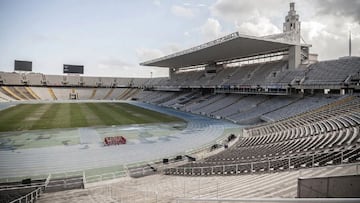LALIGA SANTANDER
Barcelona to leave Camp Nou: where is Estadi Olímpic Lluís Companys in Montjuïc?
Barça are expected to play away from home for more than a season due to renovation work at Camp Nou.

Barcelona have officially informed the Royal Spanish Soccer Federation (RFEF) that they will play their home games next season away from Spotify Camp Nou, which will be redeveloped along as part of the Espai Barça project. All of the club’s facilities in the Les Corts neighbourhood of the city will be renovated, including Estadi Johan Cruyff, where Barcelona Atlètic and Barcelona Femení usually play their home games, and Ciutat Deportiva Joan Gamper, their training ground and academy base.
How long will Barcelona be away from Camp Nou?
Estadi Olímpic Lluís Companys in Montjuïc will be their new home for the next season and a bit, a stadium which some of you may know as Estadi Olímpic de Montjuïc or simply Estadio de Montjuïc. Renovation work at Camp Nou is expected to begin in June 2023 and be completed by June 2026, although their plan is to be able to return home by November 2024, following the example set by Real Madrid, who are back playing at Estadio Santiago Bernabéu amidst ongoing improvements to the ground.
Where is Estadi Olímpic Lluís Companys?
For those of you not familiar with the city of Barcelona, Montjuïc can best be described as a hill overlooking the harbour on the southwest side of town. It is where the Olympic Park was located when the Catalan capital hosted the 1992 Summer Olympics, with Estadi Olímpic Lluís Companys (or however you may wish to call it) hosting the all of the athletics competitions, as well as the opening and closing ceremonies.
When was Estadi Olímpic Lluís Companys built?
However, the stadium existed long before the Olympic Games came to town. It was built in 1927 and officially opened two years later in time for the 1929 Barcelona International Exposition, a type of World Fair. In a sporting sense, it wasn’t overly used, but did host eight Copa del Rey finals between 1930 and 1957, as well as the Mediterranean Games in 1955.
Post-Olympics use
After a long period of inactivity, it was completely renovated in time for the Olympics, initially giving it a new lease of life. Barcelona’s city rivals Espanyol played in Montjuïc for 12 years from 1997 until 2009, as did Barcelona Dragons, an American football team that played in the now disbanded World League of American Football, which later became NFL Europe. The stadium also hosted the European Athletics Championships in 2010 and a number of rugby matches.
In recent years, it has been sparsely used but that is all set to change. At the end of 2022, work began on making sure that the stadium would be up to LaLiga and UEFA standards, with the dimensions of the pitch altered and changes made to the drainage and irrigations systems in use. Work will also be carried out on the dressing rooms, the press box and the hospitality area, while provisions will also be made to ensure televisions broadcasters are able to film inside the ground.
What is the capacity?
Depending on where you look, Estadi Olímpic Lluís Companys is listed as having a capacity of between 54,000 and 60,000, significantly less than Camp Nou, which has just under 100,000.
Who was Lluís Companys?
Lluís Companys i Jover was the president of Catalonia from 1933 until 1940, when he was executed in Montjuïc by the Spanish State led by dictator Francisco Franco, having been captured in France by the Gestapo, the Nazi secret police, after the end of the Spanish Civil War in 1939. Companys is said to have played a key role in the formation of the Second Spanish Republic, the form of government in Spain which immediately preceded Francoist Spain.






